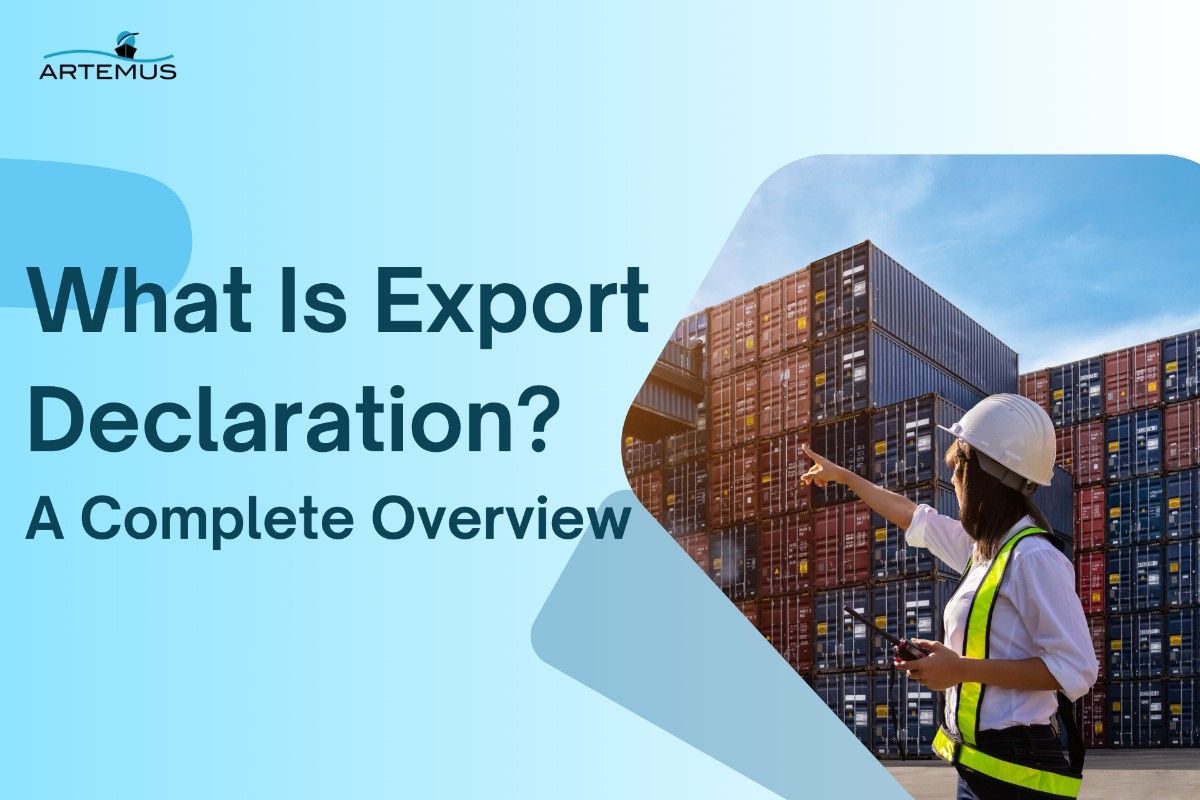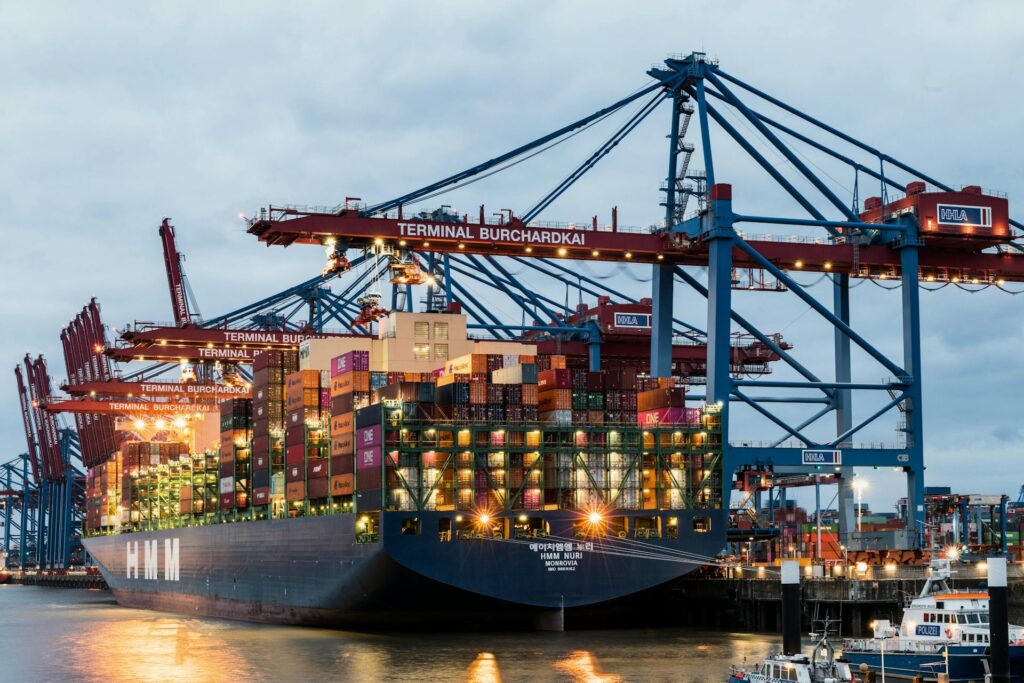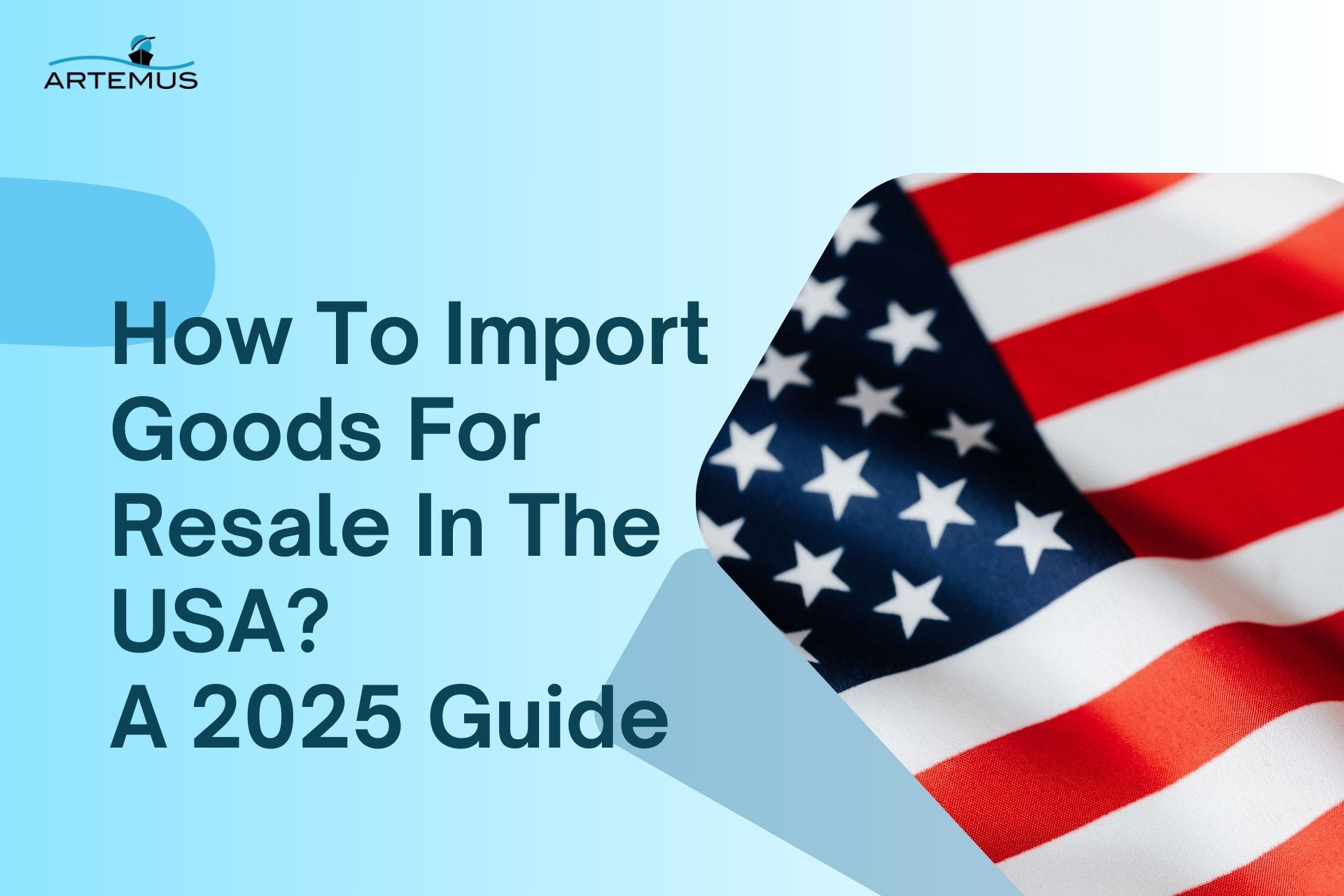
What Is Inbound Logistics & Outbound Logistics? A 2025 Guide
In the dynamic world of supply chain management, understanding the nuances of inbound and outbound logistics is crucial for operational

In today’s competitive global marketplace, navigating the complexities of international trade can be daunting. One of the critical aspects of this process is the export declaration, which serves as a formal statement detailing the goods being exported and their compliance with local regulations.
At Artemus, we understand the challenges businesses & exporters face in managing export declarations accurately and efficiently. As a trusted partner, we provide streamlined export declaration services designed to simplify the process, ensuring compliance while saving you time and resources.
Whether you are a seasoned exporter or new to international trade, our expert team is here to guide you through every step, helping you navigate the intricacies of export documentation with ease and confidence. Let’s explore how our dedicated services can enhance your export operations and drive your business success.
Table Of Contents
An export declaration is a critical document required by governments and regulatory bodies that provides detailed information about goods being shipped from one country to another. It serves as an official record that facilitates the monitoring, regulation, and control of international trade.
Export declarations ensure that all exported goods comply with the legal, economic, and security standards of both the exporting and importing nations.
Related: What Is Import Compliance & Why It Matters?
A Shipper’s Export Declaration (SED) is a legal document required for international shipments that exceed certain value or product thresholds. This document contains key information about the shipment, such as the shipper’s details, description of the goods, the destination country, and the value of the goods being exported.
It serves two primary purposes: assisting customs authorities in monitoring and controlling exports and providing statistical data for trade analysis.
The SED is mandatory for shipments above certain value limits or for specific goods that are regulated, such as defense articles or high-tech equipment. In the United States, the SED is often replaced by the Electronic Export Information (EEI) form, which must be filed via the Automated Export System (AES).
Proper filing of this form is essential for compliance with export laws, and failure to do so can result in penalties. In addition to facilitating trade control and regulation, the SED also helps in safeguarding national security by monitoring the flow of potentially sensitive items across borders.
Related: Ocean Freight Documentation For Imports: A Crucial Checklist

Export declaration is a critical aspect of international trade, playing a pivotal role in ensuring compliance with regulations, maintaining the smooth flow of goods across borders, and protecting national interests.
It serves as a formal statement provided by the exporter, detailing the nature, quantity, and value of the goods being shipped. Below are the key reasons why export declarations are so important:
Each country has specific customs regulations that must be followed when exporting goods. An accurate and complete export declaration ensures that all relevant authorities are informed about the goods leaving a country, helping businesses avoid penalties, delays, and fines due to non-compliance.
Many countries have trade agreements that provide preferential tariffs or duty exemptions. A properly filed export declaration is essential for exporters to benefit from these agreements, as it provides the necessary proof that the goods originate from a participating country.
The export declaration contains important information about the product, including its classification under the Harmonized System (HS) codes. Proper classification ensures that the right tariffs are applied, helping exporters avoid unnecessary costs and ensuring compliance with international trade laws.
Export declarations play a key role in preventing illegal activities such as smuggling, trafficking, and the export of prohibited goods. By requiring detailed information about the products being shipped, authorities can monitor and control the movement of goods across borders, ensuring that exports comply with national security regulations.
Governments and international organizations rely on export data to analyze trade flows, track economic performance, and develop policies. Export declarations provide valuable data for compiling trade statistics, helping to inform economic decisions, shape trade policies, and support business strategies.
A correctly completed export declaration not only facilitates smoother international trade but also enhances the credibility of the exporter. By adhering to global trade standards, exporters build trust with customs authorities, business partners, and customers, reducing the risk of disputes and fostering long-term business relationships.
Export declarations streamline the export process by providing customs and other regulatory authorities with the information they need to clear goods quickly and efficiently. This reduces the potential for delays in shipment and ensures the timely delivery of goods to international buyers.
Related: How Does Freight Forwarding Work? A 2024 Guide
The export declaration process is an essential part of international trade, ensuring that shipments comply with a country’s export regulations. The key steps in this process generally include:
Before exporting goods, prepare necessary documents such as the commercial invoice, packing list, and, in some cases, certificates of origin. Additionally, check if your goods require an export license, especially for sensitive or restricted items.
This step involves filing the Electronic Export Information (EEI) through the Automated Export System (AES) in the U.S. or similar systems in other countries.
This submission must include details such as the value, destination, and description of the goods, as well as any required export control numbers. The exporter or their authorized agent, like a freight forwarder, handles this submission.
Once the export declaration is submitted, the system reviews the data for any errors or discrepancies. If everything is correct, you will receive an Internal Transaction Number (ITN), which is confirmation that your export is registered. This number should be included in the export documentation for customs clearance.
After receiving the ITN, your goods can be reviewed by customs authorities. The shipment can then proceed to be loaded for international transport, provided all other requirements (like payment of any duties or taxes) are met.
Related: What Happens After Custom Clearance Completed? 9 Next Steps
An Export Declaration Certificate (EDC) is a crucial document required for international trade, serving as a formal declaration made by an exporter to the customs authorities. It contains key information about the goods being shipped, including the nature of the products, their value, origin, and destination.
The Export Declaration Certificate ensures that the exported items comply with all regulatory requirements of both the exporting and importing countries.
Related: What Is Harbor Maintenance Fee (HMF)? A 2024 Guide
An Export Declaration Number (EDN) is a crucial requirement for businesses involved in international trade, particularly when exporting goods. This number serves as a unique identifier for your shipment and helps ensure compliance with customs regulations.
Here’s a step-by-step guide on how to obtain an EDN:
Before obtaining an EDN, determine whether your shipment requires one. Generally, goods valued above a certain threshold, as defined by the customs authority in your country, will need an EDN for export.
To obtain an EDN, you must first register with the customs authority of the country you are exporting from. For instance, in the U.S., this involves registering for an Employer Identification Number (EIN) or Social Security Number (SSN) if you are an individual exporter.
In Australia, you would register with the Australian Business Number (ABN) if exporting from there. Each country has its system of registration, so ensure you are registered and have the necessary identification number in place.
Most countries provide an online portal for exporters to file their export declarations. For example:
Log in to the respective system using your registration details.
Once in the system, you’ll need to provide detailed information about your shipment, including:
Ensure that all information is accurate, as any discrepancies can lead to delays or penalties.
After completing the export declaration form, submit it electronically through the system. The customs authority will review the information to ensure it complies with regulations.
Upon approval, the system will issue your Export Declaration Number. This number will be linked to your shipment and used to track its movement through customs. You’ll need to provide this EDN to your freight forwarder, carrier, and other relevant parties involved in the shipping process.
For compliance purposes, it is essential to maintain records of your export declarations, including the EDN. As defined by the customs authority, these records should be kept for a set period to ensure you can present them if required during an audit.
Related: Customs Clearance Delays In 2024: Top 10 Reasons & Solutions

The Export Declaration Fee is an essential aspect of international shipping, covering the administrative cost associated with filing export declarations, which are necessary for monitoring and controlling outbound shipments.
In many countries, such as the United States, the Electronic Export Information (EEI) must be filed for goods exceeding a certain value (e.g., $2,500) through systems like the Automated Export System (AES). This data helps customs authorities track the nature of exported goods and ensures compliance with trade regulations.
The fee is often charged by freight forwarders or couriers who handle the submission of these declarations on behalf of shippers. Failing to file or submit inaccurate information can result in fines, making it crucial for businesses to stay compliant.
The cost of filing the EEI or other export declaration forms is typically a small but important part of the overall shipping process, ensuring proper documentation for customs and trade statistics.
The cost of filing an export declaration, commonly referred to as the Automated Export System (AES) filing fee, can range between $30 to $75 per shipment depending on the service provider and the complexity of the shipment. Some companies may include this as part of their customs brokerage services, while others may charge it separately.
Related: Understanding Roll-On/Roll-Off Ships: A Complete Guide
The Bill of Lading significantly influences logistics and supply chain management in the context of export declarations. It provides critical data that informs various logistical decisions, such as routing, scheduling, and inventory management.
Accurate details on the BOL help freight forwarders and logistics providers plan the movement of goods effectively, ensuring timely delivery to the consignee.
Additionally, the BOL acts as a communication tool among stakeholders in the supply chain, including shippers, carriers, and customs officials, fostering transparency and accountability.
When discrepancies arise, such as damages or losses during transit, the BOL serves as a legal document that can support claims and facilitate resolution.
Therefore, the effective management of the Bill of Lading not only aids in complying with export declaration requirements but also enhances overall supply chain efficiency, contributing to the successful movement of goods across borders.
Related: Merchandise Processing Fee (MPF): A Complete Guide
Export declaration is a critical process in international trade, involving the submission of detailed information about goods being exported to customs authorities.
Accurate declarations are essential to ensure compliance with regulations, avoid penalties, and facilitate smooth shipping. Below are common mistakes exporters should avoid to streamline the export declaration process:
One of the most common mistakes is misclassifying goods under the Harmonized System (HS) codes. Each product must be assigned the correct HS code to determine tariffs and applicable regulations. Incorrect classification can lead to delays, penalties, or even seizure of goods.
Exporters often fail to declare the correct value of goods being shipped. Underreporting the value can result in legal issues while overreporting may lead to higher duties. It’s crucial to include all relevant costs, such as transportation and insurance when determining the total value of the shipment.
Missing essential documents, such as invoices, packing lists, and certificates of origin, can cause significant delays in the customs clearance process. Ensure that all required documentation is complete and accurate before submission.
Certain goods require specific export licenses or permits. Failing to obtain the necessary licenses can result in shipment delays or legal ramifications. Exporters should research and understand the licensing requirements for their products.
Export regulations frequently change, and failing to stay updated can lead to compliance issues. Regularly review applicable laws and regulations, including sanctions, trade agreements, and export controls, to ensure your declarations are in line with current requirements.
Inconsistencies in the information provided across various documents can raise red flags during customs inspections. Ensure that the details on the export declaration match those on invoices, packing lists, and other shipping documents to avoid complications.
Maintaining proper records is crucial for compliance and audits. Exporters should keep all relevant documents for a specified period, typically five years, to facilitate reviews by customs authorities or internal audits.
Many exporters underestimate the complexities of international trade regulations. Consulting with customs brokers or trade compliance experts can help navigate the intricacies of export declarations and avoid common pitfalls.
Lack of communication with freight forwarders can lead to misunderstandings about shipping requirements and documentation. Establish clear lines of communication and ensure all parties involved in the export process are on the same page.
Before submitting an export declaration, take the time to review all information carefully. Double-checking for accuracy can prevent costly mistakes and ensure a smoother shipping process.
Related: Full Container Load Meaning (FCL) & Key Considerations
Artemus is your reliable partner for seamless Automated Export System (AES) filings, helping businesses stay compliant with U.S. export regulations.
Our advanced software simplifies the process of filing Electronic Export Information (EEI) with U.S. Customs, ensuring accuracy and timeliness for every shipment. Our AES filing solution reduces the risk of costly delays or penalties, providing peace of mind for exporters.
By partnering with Artemus, you gain access to a user-friendly platform that integrates effortlessly with your existing systems. Our expert team is always ready to assist, making sure your filings are processed efficiently, allowing you to focus on growing your business.
Related: Importing A Car From Germany To USA: A 2024 Detailed Guide
The exporter or their authorized agent is responsible for making the export declaration.
The export declaration is typically prepared by the exporter or a customs broker on behalf of the exporter.
In India, the export declaration form is a document that provides details about the goods being exported, including their value, quantity, and destination, and is required for customs clearance.
The export declaration form is provided by the customs department in India and can often be obtained from customs offices or online portals.
The export declaration is created by the exporter or their representative, such as a customs agent or freight forwarder.
Yes, an export declaration is required for customs clearance to ensure compliance with regulations and proper documentation of exported goods.
The purpose of the export declaration is to provide the government with information about goods being exported for regulatory, statistical, and trade control purposes.
To get an export declaration number, you need to submit the export declaration form to the customs authorities, who will issue a unique number upon acceptance.
Proof of export can include documents such as the bill of lading, export invoice, and export declaration, confirming that goods have left the country.
The number of documents required for export can vary but typically includes the export declaration, commercial invoice, packing list, bill of lading, and any relevant permits or certificates.
An export declaration PDF refers to the digital format of the export declaration form, which can be filled out and submitted electronically.
The cost of an export license varies depending on the country, the type of goods being exported, and any associated fees set by the relevant authorities.

In conclusion, understanding export declaration is essential for businesses engaged in international trade. It ensures compliance with regulatory requirements, minimizes the risk of delays, and facilitates smooth customs processing.
By accurately completing export declarations, companies can enhance operational efficiency and build strong relationships with customs authorities. Ultimately, a thorough grasp of export declaration not only safeguards against penalties but also contributes to the overall success of export operations. Embracing best practices in export declaration can lead to a more streamlined and profitable export experience.
Related: Less Than Container Load (LCL) Shipping: 2024 Guide

In the dynamic world of supply chain management, understanding the nuances of inbound and outbound logistics is crucial for operational

In today’s interconnected world, businesses rely heavily on global trade to expand their markets, access new resources, and drive growth.

Importing goods for resale in the USA presents a lucrative business opportunity, but navigating the complexities of U.S. customs regulations,
Get In Touch
Artemus’ Software Solutions for ISF, AMS, Japan AFR, eManifest Canada, & Panama B2B filings.